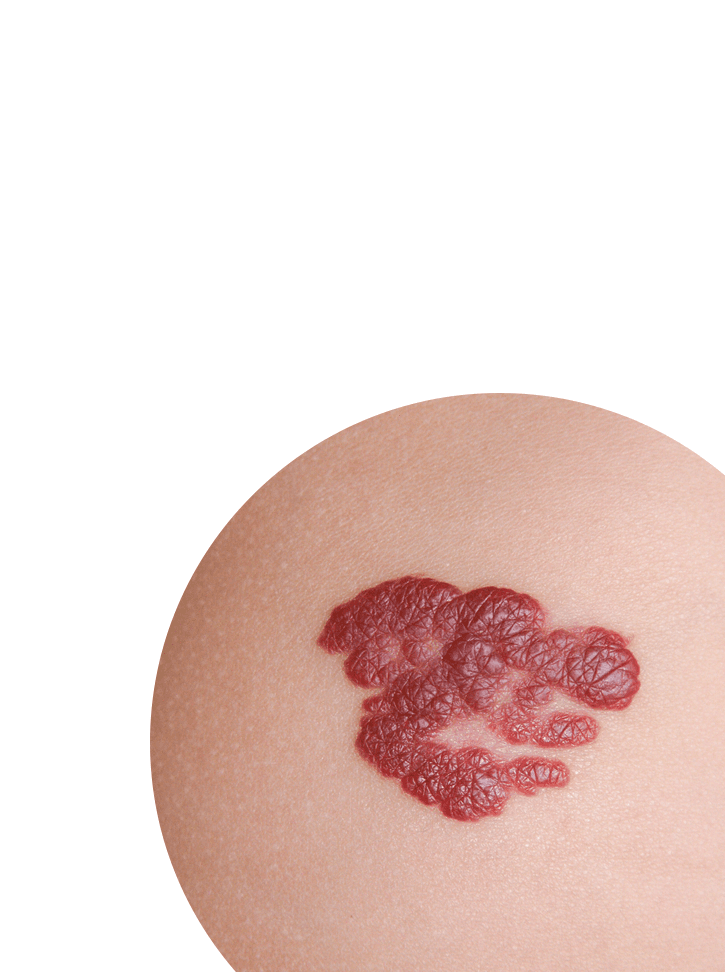
Angiomas and Birthmarks
If your baby is born with marks on their skin, you may feel scared and worry that it is something serious.
In most cases, birthmarks are harmless skin irregularities. They appear at birth or shortly afterward, and rarely require treatment.
How can I tell if my child has a birthmark rather than something more serious?

Birthmarks Come in Many Shapes and Colors
Flat and Pigmented
In many cases, birthmarks appear as flat sections of differently colored skin. Colors can range from a light pink, or salmon color, to a dark red. Other types may appear as light brown or blue gray.
Raised and Red
One of the most common types of birthmarks are hemangiomas. These typically develop within the first few months of birth as raised pink, bluish, or red bumps on the skin.
Small, Round Spots
Moles are sometimes considered birthmarks. They are usually small, round brown spots, but can be pink, skin-colored, or black.
Premature Babies and Certain Ethnicities Are at Higher Risk for Birthmarks
The risk factors for birthmarks vary based on the type. For example, hemangiomas are more common on babies who are:
- Female
- Fair-skinned
- Premature
- Less than five and half pounds at birth
- Twins or triplets
Large, blue-gray birthmarks called slate gray nevi are more common for babies with dark skin or who are of Asian descent.
But what actually causes birthmarks?
Birthmarks Can Be Caused by Groups of Blood Vessels or Melanocytes
There are two main types of birthmarks: vascular and pigmented. Each will appear for different reasons.
Vascular Birthmarks
Salmon patches, hemangiomas, and port wine stains usually appear when extra blood vessels clump together under the skin, altering its color.
Pigmented Birthmarks
In some cases, the cells which provide color to our skin cluster together. Called melanocytes, these cells form moles, café-au-lait spots, and other types of pigmented birthmarks.
“Birthmarks are common. Research shows that about 10% of babies are born with a type of birthmark known as a hemangioma. Fortunately, most hemangiomas go away on their own by the time a child is 10 years old. Many disappear sooner.” American Academy of Dermatology
There Is No Way to Prevent Birthmarks, But You Can Put Your Mind at Ease
Most birthmarks are completely harmless and pose no risk to children. However, in some rare cases, birthmarks can develop complications later in life.
See a Dermatologist
As soon as you notice a mark on your baby’s skin, have it checked out by a dermatologist. They can tell you what type of birthmark it is and whether you need to worry about it.
Keep an Eye on It
Birthmarks typically change as children grow. They may grow quickly and then suddenly fade. If your child seems to be in pain or the birthmark breaks open, call a dermatologist. They can ensure your child is healthy.
Usually, Birthmarks Are Diagnosed with a Simple Visual Exam
In most cases, your child’s doctor can identify the type of birthmark simply by the appearance of the skin. They may use a device called a Wood’s lamp to get a better view. Deeper birthmarks may require other tests, such as an MRI, ultrasound, CT scan, or biopsy.

During your appointment, your doctor can advise you on what to expect as your child grows and whether you have any cause for concern. Since most birthmarks are benign, your child may not need any treatment at all.
However, dermatologists often recommend treatment for:
- Strawberry hemangiomas on the face or groin: This type of birthmark often grows quickly and can sometimes interfere with normal function.
- Port wine stains: This type of birthmark typically does not fade. Early treatment is more effective and can prevent the mark from growing.
- Large or very visible birthmarks: Your dermatologist may recommend treatment if the birthmark could affect your child’s appearance and self-esteem later in life.
Treatments Can Reduce the Size of Birthmarks or Remove Them Completely
Laser Therapy
Commonly used for port wine stains, laser therapy can reduce or eliminate birthmarks close to the surface of the skin.
Corticosteroids
For hemangiomas and other raised birthmarks, corticosteroids can stop the mark from growing or shrink it.
Other Medications
Medicines such as Propranolol, Timolol, and Interferon can minimize the appearance of birthmarks.
Surgery
If your child has a birthmark which could potentially become skin cancer, such as a mole, surgery can remove the mark. Generally, dermatologists recommend waiting until they reach puberty to perform surgery.
Make an Appointment
Most birthmarks are harmless and no cause for alarm. However, if you or your child has a birthmark, scheduling a consultation with a dermatologist can relieve feelings of worry or concern. Whether you wish to treat a birthmark for aesthetic reasons or your child needs treatment to avoid complications, a dermatologist can help you find the right option.
